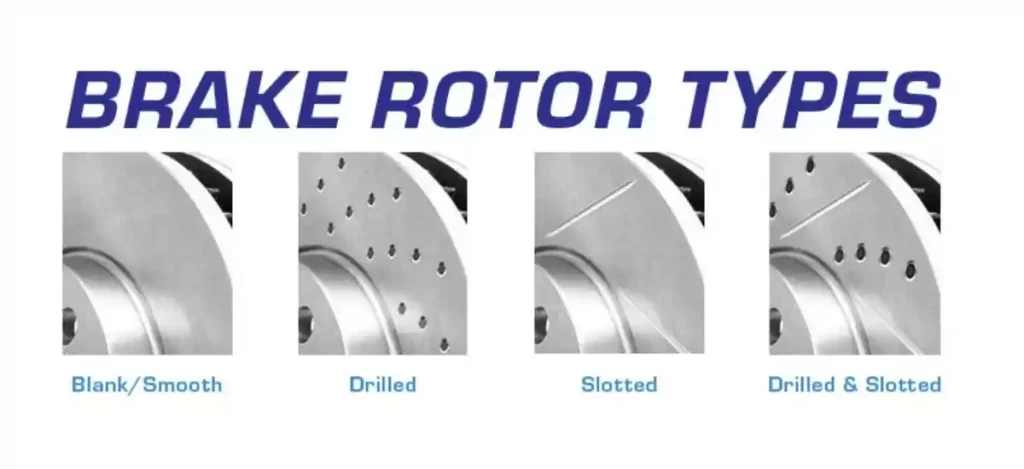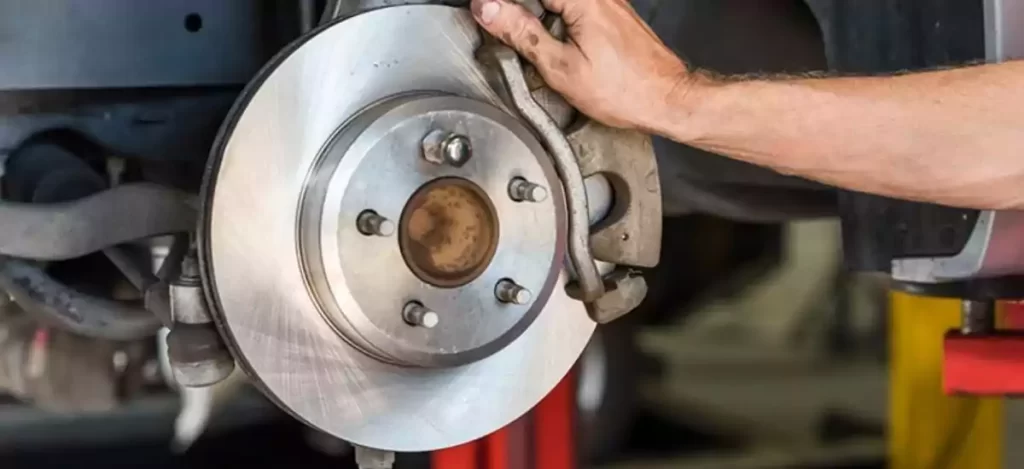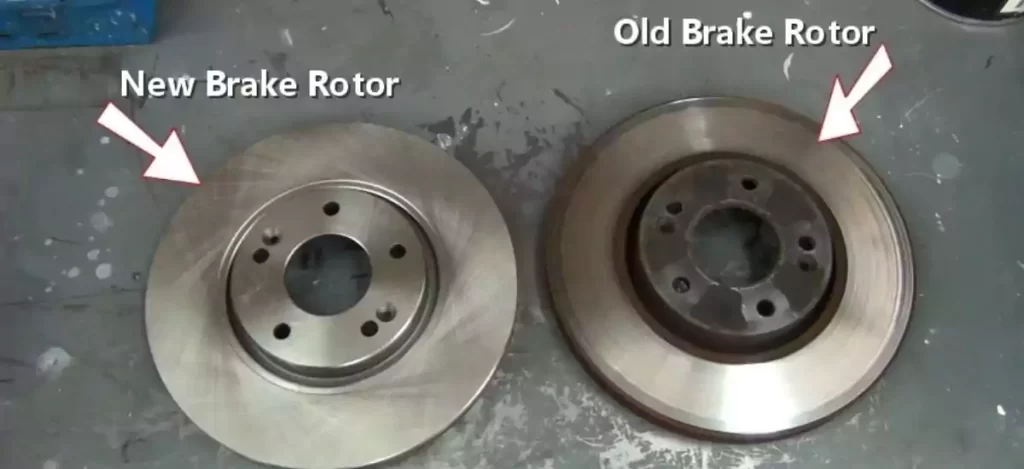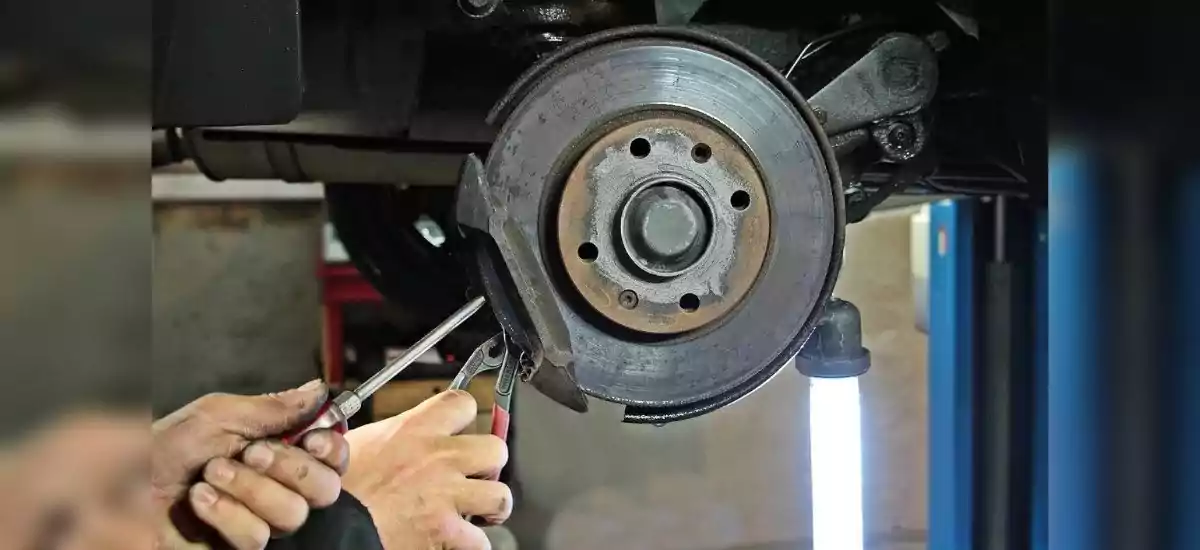The circular discs connected to each wheel of the car are known as brake rotors. Rotors are used to convert kinetic energy (movement) into thermal energy (heat). When we press down on the brake pedal, the master brake cylinder sends a signal to the calipers, which causes the brake pads to squeeze together against the rotors’ large surface area.
The friction created by pressing the pad against the rotors resists the wheel’s spin, slowing its rotation and bringing the car to a halt.
To withstand the heat, brake rotors are made of steel. Ribs or gaps are commonly found on brake rotors to allow heat to dissipate efficiently during braking. Every car must have a reliable braking system in order to drive a car safely.
Modern vehicles use a combination of components to successfully slow and stop moving vehicles, particularly when traveling at high speeds. Brake rotors are one the most important parts of any braking system.
How Many Brake Rotors Does A Car Have?
In cars, there are four brake rotors, one for each wheel. The primary function of the rotors is to use friction to slow down the rotation of the car’s wheels. When calipers squeeze your car’s brake pads together, the brake rotor process begins.
It is not necessary to replace all four rotors at the same time, but replacing the rotors & pads as a set for each axle front or back is recommended. If the front brakes are required to be replaced, but the rear brakes are still in good condition, the rear brakes do not need to be replaced.
Brake rotors are used in conjunction with other braking components to slow and stop your vehicle. Apart from gradual slowing due to friction with the air and the road, without brake rotors, the vehicle would be unable to safely stop or slow down after acceleration.
Types Of Brake Rotors
In the car, there are four different types of brake rotors:

- Smooth & Blank: Most passenger vehicles have blank and smooth rotors, which have a smooth, blank metal surface all the way around the rotor.
- Drilled: Drilled rotors have holes drilled into the metal surface.
- Slotted: Long “slots” or lines in the metal surface characterize slotted rotors.
- Slotted and Drilled: Drilled and slotted rotors have drilled holes and slots to improve performance.
Smooth & Blank Rotor
For passenger vehicles, this is the most common rotor type, such as most standard sedans, which are blank & smooth. Blank rotors are both simple & not very costly.
However, some manufacturer-specific blank rotors may be made from recycled steel. As a result, some blank & smooth rotors do not perform as well as other rotor types or last as long.
Original equipment manufacturer rotors typically last longer because their internal fins are thicker, allowing them to cool the brake pads more effectively as they are squeezed.
Drilled Rotors
Drilled rotors have holes drilled in a spiraling pattern across the surface. The holes help distribute heat and allow dust and water to escape the rotor’s surface without clogging or damaging the braking system.
Drilled rotors are commonly preferred by drivers who live in wet climates because the design aids braking in bad weather. On the other hand, drilled rotors do not last as long in high temperatures and are therefore not commonly used in racing vehicles.
Slotted Rotors
Slotted rotors have unique slots positioned around the exterior rotor surface instead of holes. Slotted rotors are commonly used on heavy-duty trucks and SUVs, as these larger and heavier vehicles require more stopping power. Those who frequently tow heavy loads in their vehicles prefer slotted rotors.
More air can flow between the rotor surfaces and the brake pads, thanks to the slots. The rotors cool & dissipate heat more efficiently as a result, and debris accumulates less over time. On the other hand, slotted rotors do not last as long as other types and can wear down brake pads more quickly.
Slotted And Drilled
Outside of the brake rotor surface, they have spiral patterns of drilled holes and slots.
High-performance vehicles typically use these brake rotors. A good example is sports cars. Such vehicles rely on top-tier cooling & heat dissipation to achieve incredible performance.
Also Read :
How Many Quarts of Transmission Fluid You Should Add to Car,
What’s Causing Your Car to Squeal? Consider The Following 5 Reasons
Common Causes Of Rotor Worn
The surface of a new rotor is smooth and even. One will notice smooth braking as the brake pad makes contact with the even rotor. The rotors may lose their smooth finish over time. Increased stopping distances and braking performance are the results of worn rotors. Listed below are some common causes of worn rotors.

- Surprise stops: Rotor wear can be caused by panic or emergency braking at high speeds. The friction between the brake pad & the rotor can generate enough heat to cause wear.
- The brake rides: Constantly slamming on the brakes can cause a buildup of heat, which can lead to wear. When driving down a hill, instead of braking all the way down, consider shifting to a lower gear.
- Wearable brake pads: Driving on worn brake pads for an extended period of time can cause rotor damage. When a brake pad wears down, the metal underneath becomes exposed, resulting in metal-on-metal contact when the brakes are applied. Deep grooves in the rotor can form as a result of this harmful contact between the pad and the rotor.
The Average Life Of Brake Rotors
Brake rotors should be replaced every 50,000 miles (80,467 km). A good set of rotors can last anywhere from 30,000 to 70,000 miles (48,280 to 112,654 km). Brake pads have a similarly long life expectancy, but it’s unusual to get more than 70,000 miles out of a set of Rotors and Pads.
A number of factors determine the average life of brake rotors.
- Brake pad type on the vehicle
- The castings’ hardness and quality
- How effective the rotors are at cooling themselves
- How is the vehicle operated?
- The driver’s braking technique (aggressive or easy)
- Moisture and road salt exposure
When Should Brake Rotors Be Replaced?
Brake rotors, like brake pads, wear down a little with each application of the brakes. While older brake rotors were designed to last two or three brake pad replacements, newer models can worn out at the same rate as your brake pads. As a result, replacing them at the same time as the brake pads may be a good idea. The following are common signs that individuals need new brake rotors:
- When braking, there is a grinding noise.
- Stopping with pulsing or shaking
- On the rotor’s surface, one can feel grooves or ridges.
- Rotors with rusted or thinned visibility
- Brake performance has deteriorated.
Brake squeaking or squealing, a brake system indicator light on, veering to one side when braking or decreased brake performance that causes you to take longer to stop are all indications that you need brake rotor service. The source of these symptoms could be the brake pads, brake fluid, master cylinder, or caliper.

Comparison Between Brake Disc And Brake Rotor
| Basic of difference | Brake Disc | Brake Rotor |
| Price | The cost of disc brakes is higher than that of rotor brakes. | The cost of a rotor brake is less than that of a disc brake. |
| Braking force | It’s a system that brakes quickly and effectively. | It’s a system that brakes slowly. |
| Temperature | High temperatures do not affect performance. The brakes are effective even in extreme temperatures. | At high temperatures, performance suffers. |
| Heat dispersion | Heat is dispersion more quickly. | Heat is dispersion more slowly. |
| Characteristics | Disc brakes have better anti-fade properties than drum brakes. | Rotor brakes with poor anti-fade performance. |
FAQS-
What Is The Cost Of Replacing Rotors On A Car?
Each rotor costs between $30 and $75. Higher-quality rotors, such as Duralast Gold, cost a little more because they have a coated hat & edge and are designed to outperform the vehicle’s original equipment. The cost of replacing rotors and pads at a shop is about $150 to $200 per axle.
Can You Drive With Broken Rotors?
No, a car with broken rotors and no brake pads cannot be driven. The car is a moving mass of one or more tonnes, and the only thing that brings it to a halt is the presence of intact rotors and pads. Driving with warped rotors is not recommended, as the brake rotors may crack or break, resulting in a significant loss of braking power. When brake rotors become worn, the amount of force used to move the steering wheel back and forth can be violent, causing the driver to lose control.
Are Rotors And Brake Pads The Same?
They are not the same.
Rotors: Disc brakes, also known as brake rotors, are typically found on a car’s front two wheels. The vehicle’s brake pads clamp down on the rotors to keep the wheels from spinning.
Pads for brakes: The brake pads make contact with the rotors and apply pressure and friction. Once that pressure is applied, the wheels will stop turning, and the vehicle will come to a halt.
Read More :
How Many Axles Do Cars Have?,
How much psi should a tire have?

